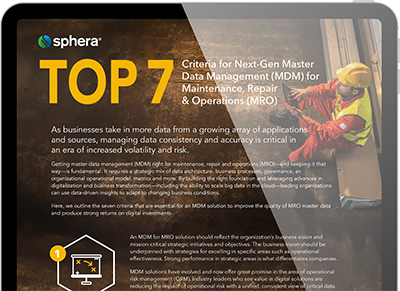For our annual look at the year ahead, we asked Sphera’s subject matter experts to outline threats to effective operational risk management (ORM). Through their years of ORM experience, which includes discussions with customers and partners, they identified and evaluated the greatest challenges companies are likely to see this year.
Specifically, our experts asked themselves: Which factors might endanger worker safety and health? Where are the risks to the plant or the environment? What could affect productivity and sustainability? Read on for our take on the top 10 operational risks for 2024.
1. Geopolitical conflict with economic implications
In 2023, we witnessed the outbreak of war in the Middle East, which has led to Houthi attacks on cargo ships in the Red Sea. The attacks are disrupting global maritime trade and introducing more uncertainty in markets that have already been affected by the war in Ukraine.
Shipping companies that use the Red Sea and Suez Canal to transport goods are having to reroute their fleets around the African continent. This adds as many as 10 days and as much as $1 million in additional fuel costs for every round trip between Asia and Northern Europe, according to the Canadian Broadcasting Corporation. On the other hand, ships that continue to use the Red Sea face growing insurance rates.
Suppliers must weigh the risks of using the Red Sea against the costs associated with using the longer, alternative route. Businesses that depend on commodities, fuel and critical spare parts for maintenance, repair and operations that are transported through the Red Sea must determine the financial and operational impact of delayed shipments and increased costs.
2. Continued labor shortages
As industrial countries experience population aging, companies are losing some of their most experienced workers. This is coinciding with skill and labor shortages, and together, the trends have the power to impact facility maintenance, inspections and the safety of assets and employees—and by extension, a company’s reputation.
Digital ORM solutions can help businesses capture and share the knowledge of experienced workers, and they can provide greater visibility and actionable information that allow for stronger decision-making and management.
Businesses that haven’t deployed digital solutions for operational risk management and process safety management are missing out on resources that can boost safety and productivity while helping companies cope with the loss of expertise.
3. Failure to operationalize sustainability
New regulations are mandating transparent reporting of companies’ safety and environmental metrics. Even companies that don’t fall within the scope of sustainability reporting directives are expected by stakeholders to achieve greater sustainability. This puts the management of supply chains, GHG emissions, plant maintenance, process safety and a host of other items under the spotlight.
The EU’s Corporate Sustainability Reporting Directive and Corporate Sustainability Due Diligence Directive, for example, will require businesses to report environmental, social and governance metrics. More specifically, companies must report on working conditions for employees and supply chain workers as well as GHG emissions and impacts on water and biodiversity, among other things. Companies must show that they are addressing any negative impacts they’ve identified. Inadequate remediation may lead to fines and reputational damage.
4. Supply chain compliance
Along the entire supply chain, human rights, worker health and safety are in focus. Increasingly, enterprises must attempt to uncover unethical business practices in their supplier network, as recent legislation illustrates:
• Germany’s Supply Chain Due Diligence Act (LkSG) requires enterprises to take specific measures to ensure that their suppliers respect human rights.
• As mentioned, the EU Corporate Sustainability Due Diligence Directive (CSDDD) will require companies to conduct due diligence in their supply chains as well as in their operations and among their subsidiaries. Businesses must address any negative environmental, social and governance impacts they detect.
• The Uyghur Forced Labor Prevention Act (UFLPA), enacted in 2021, prohibits the import into the U.S. of goods made using forced labor, primarily from China’s Xinjiang Uyghur Autonomous Region.
Digitalizing processes for supply chain risk management helps companies meet and exceed ever-changing regulatory requirements. A cloud-based solution can simplify and support ESG compliance in the supply chain.
5. Digital resistance
In our Process Safety Report 2023, survey respondents indicate support for digital tools: 100% said it already enabled process safety management or would do so in the future. Yet the rate of technology adoption in companies does not reflect the same enthusiasm.
In terms of process safety, technology advances an organization’s ability to protect its people and assets. It helps them avoid hazards and safety incidents by establishing standardized processes and monitoring activity in real time. It allows them to use risk indicators to proactively address risk. It enables the performance of critical maintenance while minimizing downtime.
In short, digital process safety solutions optimize safety in the plant, on the pipeline, in the mines—wherever people and assets are exposed to danger. Organizations that avoid implementing these solutions leave themselves exposed to unnecessary risk.
6. Extreme weather events
Any industry can become impaired when facilities, suppliers, supply paths or distribution networks are impacted by severe weather events. In November last year, the Prevention Web site of the U.N. Office for Disaster Risk Reduction shared results from a recent survey that found that the prospect of extreme weather concerns businesses more than cyber-related risks and interstate conflict.
Wildfires, extreme heat that affects employees and heavy rainfall and flooding are among businesses’ biggest concerns. In fact, 73% of respondents reported that they had already been affected by extreme weather. According to the survey, the manufacturing sector is most heavily impacted.
Climate experts, including the U.S. National Oceanic and Atmospheric Administration (NOAA), say extreme weather events are increasing in frequency and intensity. This results in more damage and danger on sites, more repairs and more downtime.
Businesses can’t control a hurricane, wildfire or any other extreme weather or climate-related event. But they can—and should—take steps to mitigate the impact of extreme weather events on their employees and assets. Companies are now expected to disclose climate-related financial risks, and as companies consider these financial risks, they must also understand and mitigate the operational risks linked to climate change.
7. Impact of delayed commodity supplies
According to U.S. Customs and Border Protection, 43% of shipments reviewed under the UFLPA from June 2022 through December 2023 were denied entry into the U.S. Electronics topped the list, with industrial materials in third place. This means that essential parts for repair and maintenance, or the rare earths and metals for producing such parts, could be delayed.
To avoid compliance violations, supply shortages and backlogs, all of which can compromise safety, companies need to monitor and track commodity risk. Companies can use this information to create action plans and alternative scenarios to avoid problems before they arise.
8. Inadequate cybersecurity
In a 2023 survey conducted by IT governance association ISACA, 38% of respondents reported an increase in cyberattacks compared to the previous year. Cyberattacks can cripple operations or result in downtime and maintenance delays that contribute to operational risk. In January, the FBI even warned of attacks targeting critical infrastructure, including power plants and electric grids, water treatment plants, oil and natural gas pipelines and transportation hubs.
A 2023 report by IBM estimates the average cost of a data breach at $4.45 million. The high costs and consequences should prompt companies to keep their security up to date.
9. Challenges related to changing energy markets
The energy market is in a state of flux—potentially a very dangerous one. Currently, gas, coal and oil still provide fuel for a huge amount of primary energy consumption. Yet with the global agreements to transition away from fossil fuels, attention is focused on renewables and electrification.
So, fewer fossil fuel power plants and refineries are coming online, and less new investment is going into aging facilities. In this era of transition, it becomes even more critical to ensure the safety, efficiency and sustainability of existing assets—many of which are well beyond their design life. Older plants might present a greater risk and also may need to be updated to adhere to stricter environmental standards.
10. Changes caused by mergers and acquisitions
Following last year’s dip in merger and acquisition activity, new deals are expected to increase in 2024. Yet changes in ownership structure can compromise safety.
A mismatch in corporate safety cultures and processes often follows mergers. People might ignore new ways of doing things or take shortcuts. Establishing or enforcing corporate safety standards across the acquired businesses could be inhibited by differences in culture.
Process safety software contains built-in procedures that provide guardrails for proper frontline behavior. Digital systems are also readily scalable for greater standardization across newly formed or expanded organizations.
Companies will also have to integrate or consolidate multiple databases, including those for purchasing functions and spare parts. In such cases, an MRO master data solution is key to sustaining data as a long-term asset, while realizing productivity and safety benefits throughout the entity.

How to improve operational risk management in 2024
The operational risk spectrum is broad. Risks to safety and productivity can arise through macroeconomic factors as well as from changes in company ownership. Extreme weather can threaten process safety and disrupt supply chains. Human rights or environmental violations can restrict the availability of supplies or commodities.
In all areas, digitalization remains key—even a business imperative—for improving safety, while supporting productivity and sustainability. Digital tools provide supply chain, process safety and operational risk managers with real-time data, improve risk awareness and enable information sharing across the organization. A well-structured database can help bridge the skills gap by providing a repository of knowledge that is accessible to all.
Among other benefits, digitalization can streamline processes and support data-driven decisions that serve to reduce injury and incidents. People want to work at companies that protect them, so they can return home to their families each day. Employees with a positive attitude are more likely to do their part for safe, sustainable and productive operations.










